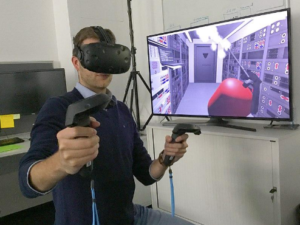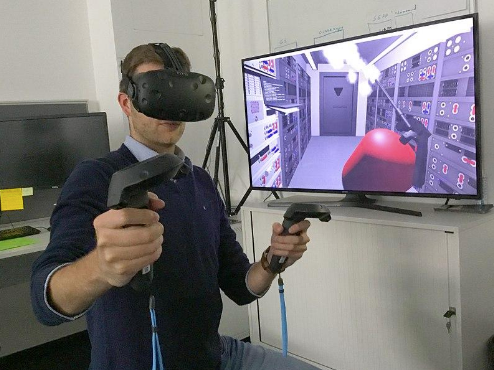
VR/AR
The answer to that question is a definite yes. In fact, virtual reality is already changing the way students acquire new information and develop essential skills. Here at Hacked Education we’ve previously written about apps, methods, and companies that are making educational VR a possibility in some classrooms.
For instance, Merge VR offers marshmallow-soft goggles that work with nearly all kinds of Android and iOS smartphones, including a mini version designed to fit on children. Merge combines this technology with the “cube,” an augmented reality program in which users are able to hold and interact with virtual holograms using their hands. This allows students to hold, view, and rotate 3D models of dinosaur fossils, human skeletons, and other objects in the curriculum, giving them the freedom to observe the objects from any angle in virtual space.
According to Forbes, there are many other ways that both VR and AR are transforming basic to advanced education. Back in 2017, toymaker Thames and Kosmos and video game designer Schell Games collaborated to create Happy Atoms – a system that gives students a hands-on experience combining atoms and molecules. It consists of physical models of atoms clearly marked with their respective atomic symbols, flexible electron arms with built-in magnets for creating different atomic bonds, and an iPad app that allows students to scan and learn more about the molecules they’ve built.
Another company that’s taking educational VR to the next level is Lifeliqe (pronounced: lifelike). This system replaces traditional presentations with educational 3D journeys into locations that are otherwise inaccessible to students. Lifeliqe comes with more than a thousand immersive 3D images and simulations designed for educational purposes. This includes exploring volcanoes, inspecting grazing dinosaurs, walking inside the cellular structure of plants, swimming near the ocean floor, walking through human anatomy, spacewalking outside the Hubble Telescope, and embarking on other scientific adventures. Students can even use the app to take parts of the available 3D images and use them in their own academic reports, enhancing creative possibilities in the classroom.
Educational VR and AR are also seeing lots of use outside of the traditional classrooms. Fast Company in their article ‘Seven Ways AR May Change Your Life’, cite some other industries that are finding various practical uses for the currently available AR technology. In the field of medicine, Startup Proximie is allowing veteran surgeons to remotely view ongoing operations in the real world, while providing AR instructions to physicians performing the operations – essentially revolutionizing how operation/surgery techniques are taught and developed. In many institutions medical students are already able to carry out and practice complex medical procedures using VR and AR technology.
Maryville University states that VR and AR is only now starting to take shape and make real progress. As young students become more comfortable with using VR and understand its many uses, especially in education, it will get utilized more in the classroom as well as adding a completely different dynamic to learning.
You can clearly see from the above examples that this new tech won’t just be limited to video games, smartphones, and entertainment. As VR becomes more and more advanced, it will continue to streamline basic to advanced education, provide simulated training platforms for expensive and/or dangerous scenarios, and inevitably change the way both children and adults learn and develop skills.
Feature specially written for hackededu.com
Written by: Janice Baxter


2 Comments on “Will VR Change How Students Learn Guest Post via Janice Baxter”
Pingback: This Week in Ontario Edublogs | voicEd.ca
Great article. Your blog is very resourceful.
I will guide students present at my online talent optimization platform.